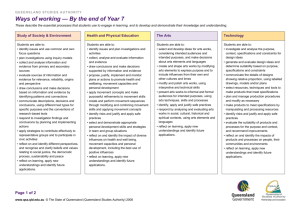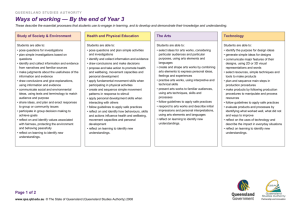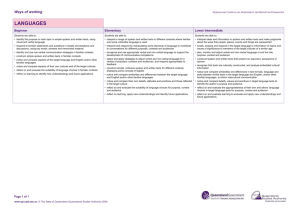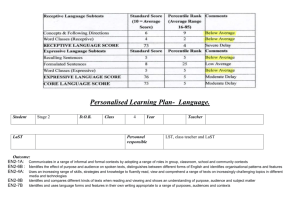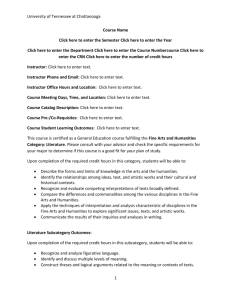DOCX, 48 kB
advertisement
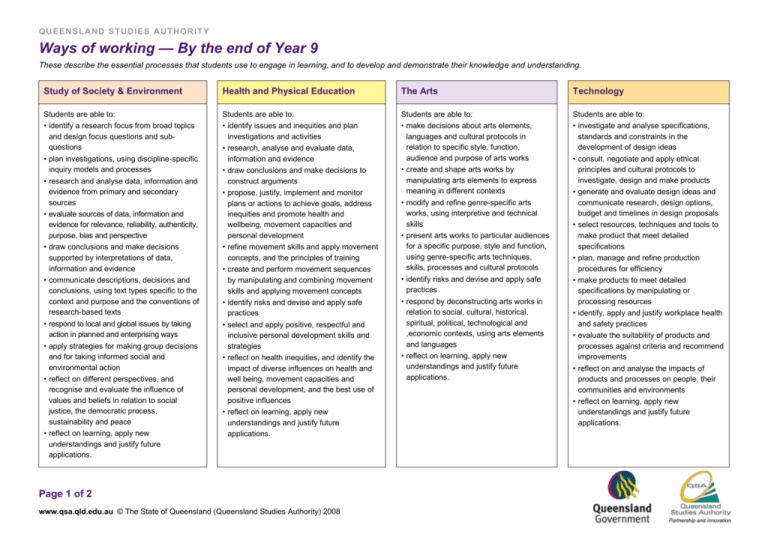
QUEENSLAND STUDIES AUTHORITY Ways of working — By the end of Year 9 These describe the essential processes that students use to engage in learning, and to develop and demonstrate their knowledge and understanding. Study of Society & Environment Health and Physical Education The Arts Technology Students are able to: • identify a research focus from broad topics and design focus questions and subquestions • plan investigations, using discipline-specific inquiry models and processes • research and analyse data, information and evidence from primary and secondary sources • evaluate sources of data, information and evidence for relevance, reliability, authenticity, purpose, bias and perspective • draw conclusions and make decisions supported by interpretations of data, information and evidence • communicate descriptions, decisions and conclusions, using text types specific to the context and purpose and the conventions of research-based texts • respond to local and global issues by taking action in planned and enterprising ways • apply strategies for making group decisions and for taking informed social and environmental action • reflect on different perspectives, and recognise and evaluate the influence of values and beliefs in relation to social justice, the democratic process, sustainability and peace • reflect on learning, apply new understandings and justify future applications. Students are able to: • identify issues and inequities and plan investigations and activities • research, analyse and evaluate data, information and evidence • draw conclusions and make decisions to construct arguments • propose, justify, implement and monitor plans or actions to achieve goals, address inequities and promote health and wellbeing, movement capacities and personal development • refine movement skills and apply movement concepts, and the principles of training • create and perform movement sequences by manipulating and combining movement skills and applying movement concepts • identify risks and devise and apply safe practices • select and apply positive, respectful and inclusive personal development skills and strategies • reflect on health inequities, and identify the impact of diverse influences on health and well being, movement capacities and personal development, and the best use of positive influences • reflect on learning, apply new understandings and justify future applications. Students are able to: • make decisions about arts elements, languages and cultural protocols in relation to specific style, function, audience and purpose of arts works • create and shape arts works by manipulating arts elements to express meaning in different contexts • modify and refine genre-specific arts works, using interpretive and technical skills • present arts works to particular audiences for a specific purpose, style and function, using genre-specific arts techniques, skills, processes and cultural protocols • identify risks and devise and apply safe practices • respond by deconstructing arts works in relation to social, cultural, historical, spiritual, political, technological and ,economic contexts, using arts elements and languages • reflect on learning, apply new understandings and justify future applications. Students are able to: • investigate and analyse specifications, standards and constraints in the development of design ideas • consult, negotiate and apply ethical principles and cultural protocols to investigate, design and make products • generate and evaluate design ideas and communicate research, design options, budget and timelines in design proposals • select resources, techniques and tools to make product that meet detailed specifications • plan, manage and refine production procedures for efficiency • make products to meet detailed specifications by manipulating or processing resources • identify, apply and justify workplace health and safety practices • evaluate the suitability of products and processes against criteria and recommend improvements • reflect on and analyse the impacts of products and processes on people, their communities and environments • reflect on learning, apply new understandings and justify future applications. Page 1 of 2 www.qsa.qld.edu.au © The State of Queensland (Queensland Studies Authority) 2008 QUEENSLAND STUDIES AUTHORITY Ways of working — By the end of Year 9 These describe the essential processes that students use to engage in learning, and to develop and demonstrate their knowledge and understanding. Languages Beginner Elementary Lower Intermediate Students are able to: • identify the purpose or main topic in simple spoken and written texts, using visual and verbal language • respond to familiar statements and questions in simple conversations and discussions, using key words, phrases and memorised material • identify and use non-verbal communication strategies in familiar contexts • construct simple spoken and written texts in familiar contexts • notice and compare aspects of the target language and English and/or other familiar languages • notice and compare aspects of their own cultures and of the target cultures • reflect on and evaluate the suitability of language choices in familiar contexts • reflect on learning to identify new understandings and future applications. Students are able to: • interpret a range of spoken and written texts in different contexts where familiar and some unfamiliar language is used • interpret and respond by manipulating some elements of language to contribute to conversations for different purposes, contexts and audiences • recognise and use appropriate verbal and non-verbal language to support the development of communicative competence • select and apply strategies to adjust verbal and nonverbal language for a variety of purposes, contexts and audiences, and respond appropriately to feedback • construct simple, cohesive spoken and written texts for different contexts, displaying some concept of register • notice and compare similarities and differences between the target language and English and/or other familiar languages • notice and compare their own beliefs, attitudes and practices and those reflected in the target culture • reflect on and evaluate the suitability of language choices for purpose, context and audience • reflect on learning, apply new understandings and identify future applications. Students are able to: • interpret ideas and information in spoken and written texts and make judgments about the ways that people, places, events and things are represented • locate, analyse and respond in the target language to information on topics and issues of significance to members of the target cultures of a similar age • plan, monitor and adjust verbal and non-verbal language to suit the role, purpose, context and audience • construct spoken and written texts that present an argument, perspective or opinion • recognise that texts are culturally constructed, and analyse embedded cultural information • notice and compare similarities and differences in text formats, language and style between similar texts in the target language and English, and/or other familiar languages, to inform intercultural communication • notice and compare beliefs, values and practices in target language texts to identify the author’s purpose and audience • reflect on and evaluate the appropriateness of their own and others’ language choices in target language texts for purpose, context and audience • reflect on and evaluate learning to evaluate and apply new understandings and future applications. Page 2 of 2 www.qsa.qld.edu.au © The State of Queensland (Queensland Studies Authority) 2008
